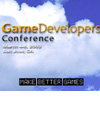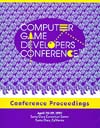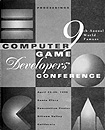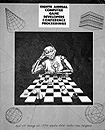AI and Design: How AI Enables Designers
Abstract: Whether you�re a programmer who�s always wanted to work on the game design or a designer who thinks there might be something to this "programming" thing, here�s your chance to talk with someone who has worked both sides of the fence. We�ll focus on AI and the ways in which AI development does (or should) overlap with the game design process, drawing case studies from the presenter�s experiences as Lead Designer for Rise of Nations, Alpha Centauri, and Civilization II. We�ll talk about why delaying AI development �until the design docs are final� is a wasted opportunity, and how both AI and Design benefit from simultaneous prototyping. We�ll explore not only the traditional use of AI to determine goals and strategy for computer players, but also the critical role of AI in supplying �personality� to computer-controlled characters. Perhaps most importantly we�ll talk about the sometimes-unexpected ways AI techniques can be invaluable in content generation.
AI: Gameplay & Design: A Marriage of Heaven or Hell?
Abstract: As AI becomes ever more complex, does this open the door for more or less gameplay? Lionhead's Jonty Barnes and Peter Molyneux will demonstrate the benefits and drawbacks AI can have on gameplay and design, by looking at games from the past, present, and future. Technology advances are always exciting and it is tempting as a developer to incorporate cutting edge technology wherever and whenever possible but a designer must always remember that the gameplay experience must be the primary consideration in any game design. However, used well, sophisticated AI can open up innumerable gameplay and design possibilities. This session looks at what has now become possible in the field of AI and what impact and effect it will have on the games of the future.
Artificial Potential Fields for the Control of Navigation and Animation
Abstract: This lecture summarizes the major ideas in the use of artificial potential fields (APFs) over the past quarter century, and show how they can be applied to games. The major topics include the theory behind APFs; designing appropriate potential and/or force functions; algorithms for using APFs in both navigation and animation; avoiding or escaping from deadends and other local minima; enforcing stability in motion; conforming to dynamic constraints; vortex fields and other APF variations; application to avoiding collisions with moving obstacles; and application to multi-agent movement in flocks or formations.
Beyond Finite State Machines: Managing Complex, Intermixing Behavior Hierarchies
Abstract: This lecture discusses the design and implementation idioms for structuring complex, hierarchical, character behavior. This includes idioms for authoring tightly coordinated multi-character behavior, such as conversation behavior. Techniques include the use of meta- behaviors to monitor and modify the execution state of other behaviors, and the use of joint behaviors to manage multi-character coordination (avoiding ad hoc communication). Finally, advantages and challenges of moving away from imperative programming (C++) to behavioral programming are discussed.
The Full Spectrum Warrior Camera System
Abstract: This lecture focuses on the details of the camera system technology used in the game Full Spectrum Warrior (FSW). The lecture covers the camera motion system, which is based on a modified version of the proportional controller often used in game camera systems. The lecture also covers the unique "autolook" feature that gives players a better view of the battlefield in situations where the view would normally be largely obstructed. Collision avoidance and high-level architecture considerations are also discussed, as well as techniques for providing feedback to programmers and designers, who need to "tune" the system for optimal performance. The lecture concludes with a discussion of the limitations of the FSW camera system, a summary of recommended practices, and ideas for future investigation.
The Making of the Official Counter-Strike Bot
Abstract: This lecture addresses the technical and design issues critical to the success of the official Counter- Strike bot, the most advanced FPS tactical multiplayer AI to date. The official Counter-Strike bot has received an enthusiastic reception from both newbies and veterans of the Counter-Strike community, largely due to the fact that it plays the game in a very believable, human-like fashion. The bots put on a "performance" that results in players feeling they are fighting against (and with) "worthwhile" opponents. Achieving this level of suspension of disbelief requires more than technical AI coding ability. It requires a thorough understanding of the game, insight into human limitations such as reaction times and attention prioritization, and a holistic sense of how to create a fun and believable "performance" from these disparate parts.
True Crime: Streets of L.A.-Bringing Crime to the City of Angels
Abstract: In the recently released game, True Crime: Streets of L.A., we created a 240 square mile city that players could explore from end to end. We then had to fill it with citizens and not a small amount of criminal activity. This session discusses the techniques we used and the problems we encountered in bringing the city to life. We needed to create a character system that would seamlessly blend innocent character behaviors with a complete fighting and shooting techniques. The design also relied heavily on both scripted and emergent behavior as a core part of gameplay both out in the city and in the interior set pieces. Showing the action also depended on the interaction of a variety of camera models. Key topics in the session will be character animation and behavioral AI, interaction between kinematic objects and the physics system, real-time cinematography, and collision detection and testing.

|

|
2003 GDC Proceedings
|
Screaming at the Machine: Using Speech Recognition as a Complement to Traditional Game Input Technique
Dave Bartolomeo (Microsoft)
Game Developers Conference Proceedings, 2003.
Topics: NLP; Genres: General
Abstract: Advances in speech recognition technology, gigahertz CPUs, and the offloading of graphics
processing to the GPU have made it practical to use speech recognition in commercial-quality
games. The characteristics of speech recognition make it a unique input device, significantly
different from a mouse, keyboard, or joystick. Speech is more flexible than keyboard commands,
easier to use than multi-level menus, and it enables players to issue commands without moving
their focus away from the primary game interface. This talk demonstrates how to incorporate
speech recognition into your game in a way that complements traditional input devices, rather
than trying to replace them.
Sandbox Strategy Learning in Sports Games
Topics: Learning; Genres: Sports
Abstract: The illusion of intelligence is most easily destroyed by predictable or static behaviour. The ability for game characters to learn and adapt to the game player's actions will become increasinly important as the AI in games develops. Yet in many games, specifically in all sports simulation games, the AI must be kept in a "sandbox": It should not potentially evolve into nonsensical territory. This lecture focuses on a strategy learning experiment as part of an AI architecture under design in collaboration with Electronic Arts for their series of sports games.
Representational AI Planning Techniques
Charles Martin (University of Chicago)
Game Developers Conference Proceedings, 2003.
Topics: Architecture, Planning; Genres: General
Abstract: This talk presents representational AI planning techniques and how they can be layered on top
of existing game AI. These techniques explicitly manipulate representations of the world to
simulate and choose between alternative behaviors. This is contrasted with situational AI
techniques, in which behaviors depend directly on the current state. The exciting work in
game AI over the past couple of years remains primarily situational. These techniques will
always be crucial to maintaining a satisfying real-time play experience. By layering
representational planning over situational AI, we can hope to develop a more satisfying
through-line, more strategic behavior, better in-game understanding of the player experience,
and richer design vocabularies for building better games. This talk covers the essential
elements of representational planning techniques, motivated by specific game examples,
and documented with references and resources for further exploration.
Pathematics: Routing for Autonomous Agents
Alex J. Champandard (AI-Depot)
Game Developers Conference Proceedings, 2003.
Topics: Pathfinding, Movement; Genres: General
Abstract: As game AI becomes more complex, both its dependency and expectations of the navigation system
will increase. Dynamic conditions, moving obstacles and changing terrains are slowly becoming
commonplace, which the standard A* model has trouble coping with. These flaws are pointed out,
giving reasons for discarding the awkward single-pair paradigm along with the inflexible concept
of search. In this lecture, dynamic navigation systems are studied, with an especial focus on
planning. A radically new solution is proposed, redefining the way paths are requested and followed
as well as the underlying process. The result is a simple, flexible solution that can provide
dynamic level of detail path-planning with incredibly human-like motion in a surprisingly efficient
fashion.
Building AI Sensory Systems
Tom Leonard (Valve Software)
Game Developers Conference Proceedings, 2003.
Topics: Sensory, General; Genres: General
Abstract: This presentation examines the process and value of constructing AI sensory systems from gathering
requirements from game design to delivery. Efficient, high-fidelity AI sensory models can be an
invaluable tool for improving a game player's experience, enabling game designers and programmers
to construct more interesting gameplay scenarios. A well-designed sensory system can be leveraged
as central location for the tuning and optimization of information gathering, as a knowledge propagation
tool, and as a replacement for spatial triggering mechanisms. Such systems can also be a nest of tuning
problems from sensitivity issues to overly subtle behavioral shifts. Using examples from several games,
the discussion examines the design and implementation of a vision and hearing model. The presentation
then explores how the basic implementations presented can be tuned and controlled by game programmers
and designers. From there, the discussion examines the optimization problems present in these systems
and a set of available solutions. The challenges and opportunities of integrating the senses into the
rest of an AI system are considered, including limitations that may be imposed larger game architectures,
communicating to the player the state of non-binary sense states, the leveraging a sensory system to
augment team and squad behaviors, and the limits of the senses metaphor as a game construction tool.
 |

|

|
2002 GDC Proceedings
|
Polygon Soup for the Programmer's Soul: 3D Pathfinding
Greg Hjelstrom, Patrick Smith (Westwood Studios)
Game Developers Conference Proceedings, 2002.
Topics: Pathfinding; Genres: General
Abstract: One of the fundemental goals of an AI system is to avoid making the unit appear "dumb." At
the root of this challenge lies one of the hardest problems to overcome efficiently and believably:
pathfinding. Today, 3D graphics and sound technologies begin to reach a level of realism that is easily
destroyed by seeing an AI unit walk face-first into a solid wall, slide along the perimeter, and
ultimately get stuck on an errant polygon. This session addresses the pitfalls of attempting to pathfind
the arbitrary world we call "polygon soup." It also covers automatic data generation and compression,
a run-time distributed algorithm, organic post-process modifiers, and solutions for tricky situations
such as doors, ladders, and elevators.
Social Activities: Implementing Wittgenstein
Tom Barnet-Lamb (Lionhead Studios), Richard Evans (Lionhead Studios)
Game Developers Conference Proceedings, 2002.
Topics: Cooperation, Coordinated Movement; Genres: General
Abstract: In Black & White, a number of different "group minds" were implemented, such as reactions,
towns, and dances. These activities had a lot in common, but were implemented completely separately.
What was in common between them was not captured explicitly. This meant that adding a new type
of activity was quite difficult and time-consuming: all the bookkeeping had to be re-implemented
each time. This lecture proposes a new system that captures what is common between different
activities and makes it as easy as possible to add a new type. Furthermore, and more excitingly, this
new system allows the mod community to add new activities after the game has been released. This
is a good idea because the perceived "depth" of an AI agent is largely a function of the number
of different sorts of activities it can engage in. By making it optimally easy to add new activities,
we increase the total number of activities we can implement. In Black & White, the number of activities
implemented was rather small. With this new system, we hope to have hundreds of different activities.
Game Scripting in Python
Bruce Dawson (Humongous Entertainment)
Game Developers Conference Proceedings, 2002.
Topics: Scripting; Genres: General
Abstract: Scripting languages allow rapid development of game behavior without the pitfalls that await
the unwary C++ programmer. Using an existing scripting language saves the time and cost of developing
a custom language and typically gives users a far more powerful language than they could create on their
own. Python is an execellent choice for game scripting, because it is easily embedded, is powerful, can
seamlessly be extended with C/C++ code, has most of the advanced features that make scripting languages
worthwhile, and can be used for automating productions tasks as well as in the game. Additionally, the books,
development tools and libraries available for Python give great opportunities for leveraging the work
of others. This session describes the presenter's experiences with integrating Python into a game engine.
It explains why Python was chosen, what the benefits have been, what problems were encountered, and
how they were solved. This session illustrates why using an existing scripting language, rather than
creating one's own, is the smart thing to do. Python is a good choice for a game scripting language, and
integration is easy, especially with the lessons that are taught in this session.
State-Based System of Animation: Artfully Blending Animation with AI
Peter Hirchmann & Sunil Thankamushy (Dreamworks Interactive)
Game Developers Conference (Audio only), 2002.
Topics: Animation; Genres: General
Abstract: As we enter the era of next-generation gaming technology, it is very important to create solid tools
for high-quality animation performance that enable the animators and designers to do real-time magic and fully
utilize the real-time nature of this medium. With today's high-powered game systems, the animator should be
able to rise out of that tiny cubicle and create content that isn't just dead assets, but ones that are
elivened with intelligence: scripted states, behaviors, routines, patterns, and the like. Working on Medal of
Honor has been a terrific exercise in finding creative solutions to blend character animation with AI so they
may work hand in hand to enhance the immersive experience of the game. In the course of the three games that
make up the Medal of Honor universe, rigorous processes, queer methodologies, and simple philosophies have been
developed and used very effectively by the animators. This session is about sharing some of what was learned.
Action-Based Discretization for AI Search
Todd Neller (Gettysburg College)
Game Developers Conference (Audio only), 2002.
Topics: Architecture, Pathfinding; Genres: General
Abstract: For agents to act intelligently in continuous, dynamic environments, some facility for look-ahead
is necessary. In order to apply AI search techniques to continuous problems, one must first form a discrete
approximation of the continuous problem. State-space-based discretization techniques (such as waypoints and
additional state) suffer computationally when the environment is very dynamic, making it necessary to keep
track of many changing variables. An alternate technique focuses on discretizing continuous action spaces
(how to act), and action timing (when to act). So long as the environment is efficiently simulated, the
complexity (dimensionality) of the state space is irrelevant. Since complex actions can arise from a few
simple action primitives, it is possible to synthesize complex actions dynamically with search. Lecture
attendees learn about the fundemental trade-offs between state-space discretization and action/action-timing-space
discretization. Additionally, they learn new algorithms that perform such discretization autonomously.
 |

|

|
2001 GDC Proceedings
|
Creature Smarts: The Art and Architecture of a Virtual Brain
Robert Burke, Damian Isla, Marc Downiew, Yuri Ivanov, Bruce Blumberg (M.I.T. Synthetic Characters Group)
Game Developers Conference Proceedings, 2001.
Topics: Architecture; Genres: General
Abstract: This lecture describes the process of character creation from a behavior-based standpoint.
Drawing upon experience designing interactive installations, the speakers discuss the components necessary
to take a character from its initial artistic design phase through to its implementation as an
autonomous agent in a dynamic virtual world. In designing these virtual creatures, the Synthetic
Characters Group at the MIT Media Lab draws inspiration from animal behavior, experimental biology,
and the brain and cognitive sciences. The speakers discuss how the lessons drawn from these diverse
fields can inform the design of a character's cognitive architecture, perception system, short-term
and associative memory, emotion system, motor system, and learning. The primary case study used is
Duncan, an autonomous sheepdog first presented at the Game Developers Conference in 2000. Intelligence
is a problem that can be tackled in layers, by breaking its components into discreet subsystems as
suggested by nature. Under this system, in the end, doing things right is easier. Enforcing perceptual
honesty and making use of biologically inspired cognitive models results in more lifelike behavior.
Expressiveness is key; if it's in the character, show it. AI is not an afterthought; an interactive
system should be designed with AI in mind from the beginning.
The Basics of Team AI
Clark Gibson, John O'Brien (Red Storm Entertainment)
Game Developers Conference Proceedings, 2001.
Topics: Strategy, Tactical, Coordinated Movement, Cooperation; Genres: General
Abstract: With the popularity of network play growing every day, modern gameplay is moving away from
single-player modes to team-based games with cooperative goals. This change in game styles has
necessitated a change in AI, from individual AIs out to hunt down a single player to team AIs that
either help the player or cooperate in the hunt. This lecture discusses the basics of team-based AI,
drawing on the speakers' experience with games such as Tom Clancy's Rainbow Six and Shadow Watch.
Terrain Reasoning for 3D Action Games
William van der Sterren (CGF-AI)
Game Developers Conference Proceedings, 2001.
Available Online at Gamasutra, 2001.
Topics: Tactical, Movement; Genres: Action, FPS
Abstract: Terrain reasoning in 3D action games is about understanding concepts such as stronghold,
cover, ambush, and sniper location. This lecture introduces a simple yet powerful approach for
terrain reasoning, enabling the AI itself to compute these concepts. Traditionally, AI relies on hints
and scripts manually added by level designers to grasp the terrain. However, an AI that actually
understands the terrain will respond better to dynamic situations and directions issued by the
player. The terrain reasoning presented uses a waypoint graph with a high spatial density of waypoints.
Due to its density, it is a good abstraction of the terrain. Being a graph, it enables computations. The
lecture shows numerous examples of how to express terrain concepts in terms of this graph. A case
study illustrates how situational awareness, team formations, tactical pathfinding, and adaptive tactics
are implemented using both in-game and pregame terrain reasoning.
Level-of-Detail AI
Demis Hassabis (Elixer)
Game Developers Conference (audio only), 2001.
Topics: LOD AI, Simulation; Genres: General, Simulation
Abstract: As simulations become ever more complex and the need for realistic environments in games
becomes greater, the question of how to deal with large numbers of autonomous agents efficiently becomes
increasingly vital. This lecture gives a broad overview of simulations in general before addressing
the issues raised by large numbers of autonomous agents through the use of cutting-edge LOD techniques.
Various strategies are reviewed which deal with issues such as detail flipping, consistency guarantees,
networking problems, timeslicing, agent compression, and more. These points are illustrated with a
demonstration of Elixir's first game, Republic: The Revolution, which is built on a highly complex
simulation of an entire country containing hundreds of thousands of autonomous agents.

|

|
2000 GDC Proceedings
|
Pawn Captures Wyvern: How Computer Graphics Can Improve Your Pathfinding
Mark Brockington (BioWare)
Game Developers Conference Proceedings, 2000.
Available Online at Gamasutra, 2000.
Topics: A* Pathfinding; Genres: General
Abstract: For a long period of time, the study of games of thought (such as computer chess) rarely
included discussions about pathfinding. However, the two fields are highly related to one another.
Advances in computer chess searching algorithms can be used to dramatically speed up search
algorithms such as A-Star. This talk looks at a number of computer chess searching improvements
and shows, with concrete examples, how to improve A-Star-style pathfinding algorithms with these
chess derived techniques.
Terrain Analysis in Realtime Strategy Games
Dave Pottinger (Ensemble Studios)
Game Developers Conference Proceedings, 2000.
Topics: Tactical; Genres: RTS
Abstract: Terrain analysis is like a black-art. Every real-time strategy (RTS) game with a decent
AI, whether it knows it or not, does some type of terrain analysis. This lecture examines various methods
for terrain analysis as they apply to RTS games. Starting with simple topics as chokepoint determination
and building placement, the class moves on to more advanced topics such as frame-based terrain representation
and integration of terrain knowledge throughout the rest of the AI. Copious examples are provided by the way
of numberous 2D/3D demos and code snippets.
Interaction with Groups of Autonomous Characters
Craig Reynolds
Game Developers Conference Proceedings, 2000.
Topics: Movement, Flocking, General; Genres: General
Abstract: This lecture presents a methodology for contructing large groups of autonomous
characters which respond to the user's interaction (as well as to each other and their environment)
in real time. The characters are based on steering controllers under the direction of a simple
mental model which mediates between several conflicting behavioral goals. The characters
are represented graphically by 3D models with a library of animated motions which must be
choreographed by the behavioral controllers.
Formation-Based Pathfinding with Real-World Vehicles
Jim Van Verth, Victor Brueggemann, Jon Owen, Peter McMurry
Game Developers Conference Proceedings, 2000.
Topics: Pathfinding, Movement, Formations; Genres: General
Abstract: A number of papers and articles have been written about formation-based pathfinding.
Many of them, however, make the assumption that the units involved can move in any direction and can
turn on a dime. This lecture presents our solution in Force 21 to the problem of controlling
real-world vehicles in formation, what we learned from it, and what we will do differently the
next time.

|

|
1999 GDC Proceedings
|
Designing AI Engines with Built-in Machine Learning Capabilities
Zhimin Ding
Game Developers Conference Proceedings, 1999.
Topics: Architecture, Learning; Genres: General
Abstract: A game engine usually consists of a set of 3D environments and a collection of simulated
interactive characters. The behaviors of these characters are often specified in an ad hoc fashion
with if...then... statements. This is both tedious and inflexible. An alternative solution
is to assign an AI engine to each of these characters and let their behaviors evolve. This is
possible if the AI engine has built-in learning capabilities. This presentation introduces machine
learning technologies that combine system identification and optimal control into an integrated AI engine.
The AI engine does not assume any prior knowledge abou the system under its control and synthesize
an optimal control strategy at run time. Once you have completed the interface of the AI engine with
the characters through the simulated sensors and actuators, you can assign a goal to each of the
characters and let them evolve interesting interactive behaviors.
Developing an Artificial Intelligence Engine
John Laird, Michael van Lent
Game Developers Conference Proceedings, 1999.
Topics: Architecture; Genres: General
Abstract: As computer games become more complex and consumers demand more sophisticated
computer-controlled agents, developers are required to place a greater emphasis on the artificial
intelligence aspects of their games. One source of sophisticated AI techniques is the academic
artificial intelligence community. This lecture presents our recent efforts to develop a behavior engine
based on state-of-the-art artificial intelligence techniques from the academic research community.
The first part of the behavior engine is a large knowledge base of game independent goals, strategies,
and tactics. By adding a small amount of game specific information the behavior knowledge baase can
be easily applied to any game within a genre. The second part of the behavior engine is the Soar
artificial intelligence architecture, which applies the behavior knowledge base to generate intelligent
behaviors for agents in a game. Our behavior engine, which has been interfaced with Quake II and Descent III,
draws on advanced AI techniques such as goal-directed reasoning, hierarchical decomposition and machine
learning.
Steering Behaviors for Autonomous Characters
Craig Reynolds
Game Developers Conference Proceedings, 1999.
PDF and HTML versions of the paper
Topics: Movement, Flocking; Genres: General
Abstract: This lecture presents solutions for one requirement of autonomous characters in
animation and games: the ability to navigate around their world in a lifelife and improvisational
manner. These steering behaviors are largely independent of the particulars of the character's
means of locomotion. Combinations of steering behaviors can be used to achieve higher-level
goals (for example, get from here to there while avoiding obstacles, go down this corridor,
join that group of characters). This lecture divides motion behavior into three levels. It
focuses on the middle level of steering behaviors, briefly describes the lower level of
locomotion, and touches lightly on the higher level of goal setting and strategy.

|

|
1998 GDC Proceedings
|
Project AI
Mark Lewis Baldwin
Computer Game Developers Conference Proceedings, 1998.
Topics: Architecture; Genres: General
Abstract:
Multiple Character Interaction Between Believable Characters
Adam Frank, Andrew Stern
Computer Game Developers Conference Proceedings, 1998.
Topics: Architecture; Genres: General
Abstract:
Hardcore AI for the Computer Games of Tomorrow
John Funge
Computer Game Developers Conference Proceedings, 1998.
Topics: Architecture; Genres: General
Abstract:
Lies, Damn Lies, and ASR Statistics
Neil Kirby (Bell Labs)
Computer Game Developers Conference Proceedings, 1998.
Topics: NLP; Genres: General
Abstract:
Building Advanced Autonomous AI Systems for Large Scale Real Time Simulations
John Laird, Randolph Jones
Computer Game Developers Conference Proceedings, 1998.
Topics: Architecture; Genres: General
Abstract:
Natural Language Processing in 55 Minutes or Less
John O'Neil
Computer Game Developers Conference Proceedings, 1998.
Topics: NLP; Genres: General
Abstract:
Making the Play: Team Cooperation in Microsoft Baseball 3D
Steve Rabin (WizBang Software Productions)
Computer Game Developers Conference Proceedings, 1998.
Topics: Architecture, Cooperation; Genres: Sports, Baseball
Abstract: Explains a technique for coordinating 9 fielders during defensive play so that they cooperate and can dynamically cover each other's positions if needed. The technique involves using a manager entity to assign jobs by priority based on the ball and baserunner positions, instead of each player having a static job, like cover first base.

|

|
1997 CGDC Proceedings
|
Autonomous Agents: A Matter of Life and Death
Peter de Bourcier
Computer Game Developers Conference Proceedings, 1997.
Topics: A-Life, Learning; Genres: General
Abstract:
Making the Solution Fit the Problem: AI and Character Control in Crash Bandicoot
Andy Gavin
Computer Game Developers Conference Proceedings, 1997.
Topics: Scripting; Genres: General
Abstract:
Adding Extensible Custom Languages to Game Engines
Robert Huebner
Computer Game Developers Conference Proceedings, 1997.
Topics: Scripting; Genres: General
Abstract:
Representing Artificial Personalities
Greg Pisanich and Michael Prevost
Computer Game Developers Conference Proceedings, 1997.
Topics: Architecture; Genres: General
Abstract:
Issues of Autonomous Character Design
Ben Resner
Computer Game Developers Conference Proceedings, 1997.
Topics: General; Genres: General
Abstract:
Inside NHL Powerplay 96: What Are They Thinking?
David Roberts
Computer Game Developers Conference Proceedings, 1997.
Topics: Architecture, Scripting; Genres: Sports, Hockey
Abstract:
Cyberlife: A Biologically Inspired Architecture for Games
Toby Simpson
Computer Game Developers Conference Proceedings, 1997.
Topics: Architecture; Genres: General
Abstract:
Apparent Intelligence or Inanimate Objects Make Good Friends
Chip Standifer
Computer Game Developers Conference Proceedings, 1997.
Topics: General; Genres: General
Abstract:
Real AI, Part 3: Planning
W. Bryan Stout
Computer Game Developers Conference Proceedings, 1997.
Topics: Planning; Genres: General
Abstract:
Applied AI: Chess is Easy, Go is Hard
Bruce Wilcox
Computer Game Developers Conference Proceedings, 1997.
Topics: Game Trees, Search; Genres: Board Games
Abstract:

|

|
1996 CGDC Proceedings
|
Real AI, Part 2: Pathfinding
W. Bryan Stout
Computer Game Developers Conference Proceedings, 1996.
Topics: A*, Pathfinding; Genres: General
Abstract:

|

|
1995 CGDC Proceedings
|
No AI Articles.

|

|
1994 CGDC Proceedings
|
Real AI, Part 1: Game-Tree Search
W. Bryan Stout
Computer Game Developers Conference Proceedings, 1994.
Topics: Game Tree; Genres: Puzzle, Board Games
Abstract: Covers beginner to advanced techniques used to solve abstract games of perfect information, such as Chess, checkers, Othello/reversi, and tic-tac-toe. Topics include game tree, minimax search, exhaustive vs. selective search, alpha-beta pruning, transposition tables, iterative deepening, move ordering techniques, quiescence search, board representation, evaluation functions, opening and endgame databases, minimal window search, history heuristic, forward prunning, and search extensions.
